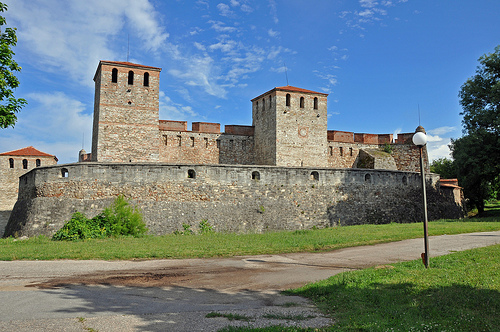

Location: Vidin Map
Constructed: 10th century
Baba Vida, also known as Vidin Castle or Baba Vida's Towers, is a medieval fortress located in the town of Vidin in northwestern Bulgaria. Situated on the banks of the Danube River at an elevation of 39 meters (128 feet) above sea level, it serves as the primary landmark of Vidin and is positioned at the northern end of a riverside park. The fortress covers an area of approximately 9,500 square meters and is renowned as the only entirely preserved medieval castle in Bulgaria, making it a significant historical and cultural site.
The origins of Baba Vida trace back to the 10th century, when it was
constructed on the ruins of the ancient Roman castell Bononia, which
itself was built in the 1st century AD atop an earlier Thracian
settlement. This initial structure formed part of Vidin's main defensive
system during the Middle Ages, acting as the citadel for the most
important fortress in northwestern Bulgaria. It withstood a notable
eight-month siege by Byzantine forces under Emperor Basil II in the
early 11th century, highlighting its strategic importance.
The
fortress saw significant enlargement and modernization during the rule
of Tsar Ivan Stratsimir (1356–1396), the last ruler of the Vidin Tsardom
within the Second Bulgarian Empire. Under his reign, Baba Vida served as
the royal capital and residence, reflecting its elevated status.
However, the region faced external pressures: between 1365 and 1369, the
fortress fell under Hungarian control after an invasion by Louis I of
Hungary, though Ivan Stratsimir regained it in 1369, albeit under
Hungarian overlordship. In 1388, the Ottomans invaded, compelling Ivan
Stratsimir to become their vassal. He later joined an anti-Ottoman
crusade led by King Sigismund of Hungary in 1396, but the defeat at the
Battle of Nicopolis allowed the Ottomans to capture most of his
territories by 1397.
During the Ottoman era, which lasted until the
late 19th century, Baba Vida transitioned from a defensive stronghold to
other uses. By the end of the 18th century, it no longer served military
purposes and was repurposed as a weapon warehouse, prison, and even a
residence for Osman Pazvantoğlu, a local Ottoman governor. The fortress
has been destroyed and rebuilt multiple times throughout its history,
incorporating layers from Roman, Byzantine, Bulgarian, and Ottoman
periods. Today, it stands as a testament to Bulgaria's medieval past,
with ongoing restoration efforts to address deterioration and preserve
its structure.
Baba Vida exemplifies medieval military architecture, featuring two
concentric curtain walls that form its defensive perimeter. The fortress
includes about nine towers, of which three are preserved to their full
medieval height, complete with original battlements. The walls are
constructed primarily of stone and brick bonded with mortar, with
thicknesses reaching up to 2.5 meters at the base in some areas and
heights varying between 3 and 15 meters. Access is limited to the
northern side, where two gates—known as the Vidin Gate and the Niş
Gate—provide entry.
The interior layout includes a main courtyard
surrounded by the inner and outer walls, along with four prominent
towers that offer panoramic views of the Danube River and surrounding
landscape. Visitors can explore a maze of medieval chambers, courtyards,
and passageways, which include remnants from various eras, such as Roman
foundations visible in the lower levels. The design emphasizes
defensibility, with features like high walls, strategic tower
placements, and limited access points, making it nearly impregnable
during its prime. Its preservation in original form distinguishes it
from other Bulgarian fortresses, many of which have been partially
ruined or altered.
The name "Baba Vida," meaning "Granny Vida" in Bulgarian, originates
from a popular legend tied to the fortress's construction. According to
the tale, a Danubian Bulgarian king divided his realm among his three
daughters: Vida, Kula, and Gamza. Vida, the eldest and unmarried,
received Vidin and the lands north to the Carpathians. She built an
inaccessible castle there, where she lived alone, leading to its naming
in her honor. Kula was given Zaječar and the Timok Valley (where she
built Kula Tower), while Gamza received lands west to the Morava River.
The sisters who married poorly squandered their inheritances, but Vida's
legacy endured through the fortress. This story reflects medieval themes
of independence and fortitude, sometimes likened to concepts like the
Iron Maiden in folklore.
Culturally, Baba Vida holds immense
significance as a symbol of Bulgarian resilience and medieval heritage.
It is one of the best-preserved fortifications in the country and
attracts tourists interested in history and architecture. The site also
functions as Vidin's summer theater, hosting traditional theatrical
events with performers from across Bulgaria, blending its historical
role with modern cultural activities.
In its current state, Baba Vida operates as a museum, showcasing artifacts and exhibits related to its history, from Roman times through the Ottoman period. It is accessible to the public, with the nearest train station in Vidin just a 20-minute walk away, and clear signage guiding visitors. The fortress is about 200 km from Sofia, Bulgaria's capital, making it a feasible day trip for those exploring the region. Efforts to restore and maintain the site continue, as it has faced wear over centuries, ensuring its legacy as a top attraction in Bulgaria.